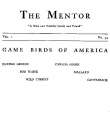You are here
قراءة كتاب The Mentor: Game Birds of America, Vol. 1, Num. 34, Serial No. 34
تنويه: تعرض هنا نبذة من اول ١٠ صفحات فقط من الكتاب الالكتروني، لقراءة الكتاب كاملا اضغط على الزر “اشتر الآن"

The Mentor: Game Birds of America, Vol. 1, Num. 34, Serial No. 34
nest.

RING-NECK PLOVER
This bird mother is brooding a chick.
The goose normally mates for life, and as its life is reckoned to last about one hundred years the partnership, barring accidents, is a long one; but life is full of accidents. The goose does not reach maturity early, and therefore does not breed for the first few years. The gander is not such a goose as he looks; for in his constant watch over mate, nest, and young he shows both courage and sagacity. He defends his mate and brood to the utmost extremity. He is said to be a victor sometimes over the crafty fox, and he easily drives away the deer or elk when his young are in danger. The goslings take to the water early; but they like to go ashore to feed on the green grass and herbage of the uplands, and there they often run into trouble. One of their greatest aquatic enemies is the snapping turtle. I have known one of these monsters to capture a full grown goose by catching its foot. In the fierce struggle that followed the goose escaped only by tearing its leg from the socket, and died a miserable death from the result of its fearful wound.

CANADA GOOSE
The male is standing and the female sitting.
When advancing winter seals the waters of their northern home, the geese gather in flocks, rise in air, and turn their faces to the south. They travel by well known landmarks, and unlike many sea fowl often become confused in a fog. Therefore, I believe they never intentionally fly out of sight of land; though they often cross wide bays and inlets.
THE MALLARD
The mallard is a cosmopolitan, the wild duck of the world, the progenitor of the domestic duck, and the chief water fowl of the game preserve. Its eggs and flesh formed a considerable part of the food of Indians and early settlers. Vast numbers of mallards formerly bred not only in Canada and Alaska, but in the western United States. Tons and tons of these birds were killed for their feathers by Indians and halfbreeds in the South and West. Boats loaded to the gunwales, wagons piled with ducks, to be given away; tons of birds spoiled before they could be shipped, then hauled out and dumped into the coulées; markets glutted and marketmen unable to handle the birds,—these were all episodes of the time of plenty. The result of this appalling waste, and the settlement of a large part of their breeding grounds, has been a tremendous decrease in the number of mallards in the country; but the birds may be readily replaced by protection and artificial propagation, and the mallard is not in any immediate danger of extinction.

BLACK DUCKS
The birds are gathering to feed.
It nests in marsh or slough wherever it is undisturbed. The little ones, when hatched, soon reach shallow water, where they are perfectly at home. They swim about the sedge and water plants, catching insects, and when danger threatens keep concealed and sheltered by the herbage. They are often in peril, not only from hawks, owls, eagles, gulls, and herons, foxes, minks, and dogs, but they are attacked on all sides in their own element. Great frogs and fish spring to seize them with open mouths. Turtles prey upon them, and in the South alligators devour many. When a dog scents the little family in shoal waters and rushes in, the mother throws herself in his way and flutters off as if sorely wounded. While he chases her eagerly, his open mouth close to her tail, the little


